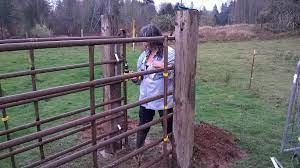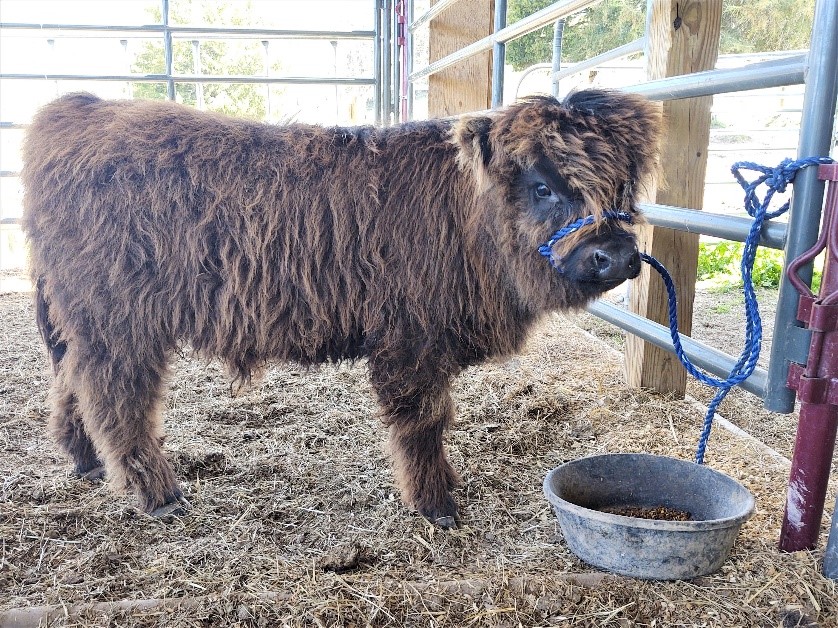– Farm Visits Policy Update –
– Mini-Lesson: Fly Control –
Farm Visits Update
We love visitors and sharing with newcomers any knowledge we have gained since our initial experience with this wonderful ancient breed of cattle. We have found ourselves hosting visitors almost daily however and that means time that we should be spending working with our calves, caring for our fold and getting to know the new faces we have brought into the pasture recently is spent with visitors, so we have to slow down.
Beginning immediately, we will be charging $25.00 for a visit that must be pre-scheduled so we don’t run into conflicts. That fee will be applied to expenses incurred when we take the time to host our visitors. An example is the additional fee for having a vet come to the farm instead of having the time to take our girls to him. Or to pay someone to work with the calves when I’m stretched too thin to spend time with the babies. I hope you understand.
Also, if you are not fully vaccinated for COVID, we will still maintain social distancing in the pastures and require masks if we are in the calf training facility and want to get close to look at the calves.
Let the Halter Training Begin

We did a bit of pre-season training with some calves who needed to get their tattoos and just happened to be handy. They are still with their mamas, so are not going to be announced for sale immediately, but it helps us brush up on our catching skills, so we got an early start. This is Elm Hollow’s Jamari and he is a quick learner!
Mini Lesson: Shoo Flies, Don’t Bother My Coos!
Cattle and their owners dread the start of fly season. It seems that no matter what you do, you can’t keep ahead of the those nasty varmints. Flies are more than just an aggravation, they can make you cows sick, cause blindness and worst of all kill calves. There are many different products on the market to help with the control of flies, but most target only some species and another product is required for other types of flies. Let’s look at a few:
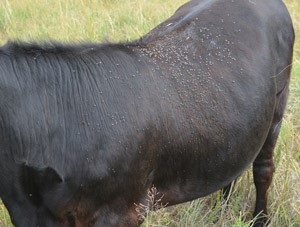
These blood sucking flies are horn flies.
Horn flies feed on cattle and draw blood about 30 times a day. This can weaken the cow, which can discourage adequate grazing and slow weight gain in beef cattle. This weakening and reduced grazing also slows milk production which affects the weaning weights of calves. These pests have also been blamed for the spread of mastitis in untreated cows.
Control of hornflies is usually done with insecticide spray or back rubbers and dust bags, but the cows resist these methods. Oral larvicides which are injested kill the developing horn flies in the manure of the cattle, but since hornflies travel up to a mile, if your neighbor isn’t treating their cows, you may get an infestation from next door. Oral Larvecides are expensive, but we find them very effective.

Face flies are responsible for the most aggravation to the cow. They feed on secretions of the eye and nose and also can feed on blood from wounds. They can cause cornea damage and pinkeye infections that left untreated lead to blindness. Treatment is difficult since it requires almost daily application of some insecticide.
Ear tags treated with insecticide are effective, but should be removed after 4 months which usually is at the peak of the fly season if they are applied at the start of the season. Another way to combat face flies is with fly traps that attract and kill both face flies and stable flies.
We saw considerably fewer face flies when we hung a couple dozen fly traps in the trees where the cattle hang out and will continue to decorate the limbs with those traps this year.

Stable Flies are biting flies that attack the legs of cattle. When cows are stomping you can be sure they are suffering the painful bites of these blood feeding flies. Spraying with insecticide and feeding oral larvecides help to control these horrid insects. I’ve been known to spray insecticide directly on the ground in areas the cows frequent when I notice a lot of clogging with no Riverdance music playing.
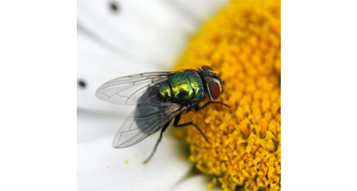
And the last type of fly we need to talk about is is the Blow Fly, sometimes called the bottle fly. This is the reason that here at Elm Hollow we try to limit our calving season to late fall and winter. Late spring and summer babies are too susceptible to the attack of these killers. This evil creature will lay eggs on the skin of a newborn calf or if mama cow doesn’t do a good job cleaning junior’s bottom around the anus or the umbelical cord of the baby. When the larvae hatch (maggots) they will eat the flesh of the calf. If left untreated, the calf will die.
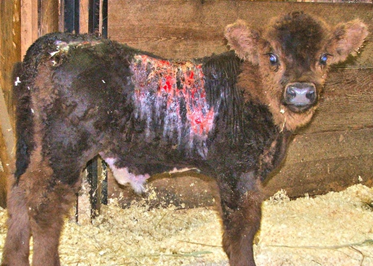
This poor baby was attacked by blow flies when it was only minutes old, before it had been cleaned and dried. The maggots burrowed into its skin after hatching in the moist bloody residue of birth. This baby was saved by quick action by the owners who noticed the infestation in time to clean and remove the larvae. (Not an easy or pleasant job.) For this reason, any calf born here during fly season is immediately treated with Ivermectin which will kill any larvae. In spite of that prcaution, we did have one suffer a minor infection due to clinging milk manure on a week old calf one time. This picture by Carole Soule.
Previous pictures of flies are from an article published by University of Nebraska – Lincoln.
Fly Control Options
Beginning in 2017 studies have been done to test the effectiveness of natural garlic in controlling flies on cattle. The studies show at least a 50% reduction in flies present on cattle that are fed garlic flavored minerals. This year, for the first time we will be introducing garlic minerals and garlic licks containing a larvaecide to fight flies. Flies do not like the smell or taste of garlic and will be less likely to light on cows that have been given garlic. Our cows seem to like their new flavored minerals.
Calving season is over except for a few cows that we purchased that are supposed to be bred. I’ll be monitoring closely for those nasty blow flies if we do have summer calves.
If you will be bringing home a Highlands for the first time this summer, have your fly control program in place. Have some type of chute and or squeeze already set up so you can manage your cows if you need to confine them to treat for flies. Bry makes a chute for long horn cattle, but you can make that into a DIY project using wooden posts, heavy duty farm gates and a little ingenuity. We started with a DIY catch that we still use on occasion.
